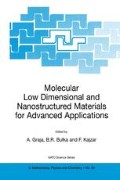Abstract
The recent progress in nanodevice technology yielded the possibility of forming so-called quantum dots (QD) or artificial atoms (AA) [1, 2]. At low temperatures and when a QD is strongly coupled to the leads, electronic transport phenomena through such a nanodevice are dominated by strong electron correlations [3, 4]. The aim of the present paper is to calculate the current tunnelling through the quantum dot in the strong coupling regime. Differential conductance vs. bias voltage dependence gives information on the density of states (i.e. the spectrum) of the investigated system. That kind of tunneling conductance spectroscopy of a two-level AA is presented. We introduce hybridization mediated effective inter-level mixing controlled by the electron correlations. Multi-level QD conductance in the strong coupling regime was investigated in [5, 6], however, the inter-level mixing was not taken into account in the calculations.
Access this chapter
Tax calculation will be finalised at checkout
Purchases are for personal use only
Preview
Unable to display preview. Download preview PDF.
References
Kouwenhoven, L.P. et al. (2001) Few-electron quantum dots, Rep. Prog. Phys. 64, pp. 701–736; references therein.
Ralph, D.C. et al. (1996) Spectroscopic measurements of discrete electronic states in single metal nanoparticles Phys. Rev. Lett. 74, pp. 3241–3244.
Goldhaber-Gordon, D. et al. (1998) Kondo effect in single electron transistor, Nature 391, pp. 156–159, Göres, J. et al. (2000) Fano resonances in electronic transport through a single-electron transistor, Phys. Rev. B62, pp. 2188-2194.
Bulka, B.R. and Stefanski, P. (2001) Fano and Kondo resonance in electronic current through nanodevices, Phys. Rev. Lett. 86, pp. 5128–5131.
Pohjola, T. et al. (2000) Strong tunneling in small quantum dots: Kondo effect in two model systems, J. Low Temp. Phys, 118, pp. 391–399.
Levy Yeyati, A. et al.(1999) Transport in multilevel quantum dots: from the Kondo effect to the Coulomb blockade regime, Phys. Rev. Lett. 83, pp. 600–603.
Gunnarsson, O. and Schönhammer, K. (1983) Electron spectroscopies for Ce com-pounds in the impurity model, Phys. Rev. B28, pp. 4315–4341.
Horvatic, B. et al. (1987) Finite-temperature spectral density for the anderson model, Phys. Rev. B36, pp. 675–683.
Costi, T.A. et al. (1994) Transport coefficients of the anderson model via the nu-merical renormalization group, J. Phys. Cond. Mat. 6, pp. 2519–2558.
Author information
Authors and Affiliations
Editor information
Editors and Affiliations
Rights and permissions
Copyright information
© 2002 Springer Science+Business Media Dordrecht
About this chapter
Cite this chapter
Stefański, P., Bułka, B.R. (2002). Tunneling Conductance Spectroscopy of the Two-Level Kondo Artificial Atom. In: Graja, A., Bułka, B.R., Kajzar, F. (eds) Molecular Low Dimensional and Nanostructured Materials for Advanced Applications. NATO Science Series, vol 59. Springer, Dordrecht. https://doi.org/10.1007/978-94-010-0349-0_37
Download citation
DOI: https://doi.org/10.1007/978-94-010-0349-0_37
Publisher Name: Springer, Dordrecht
Print ISBN: 978-1-4020-0578-7
Online ISBN: 978-94-010-0349-0
eBook Packages: Springer Book Archive

